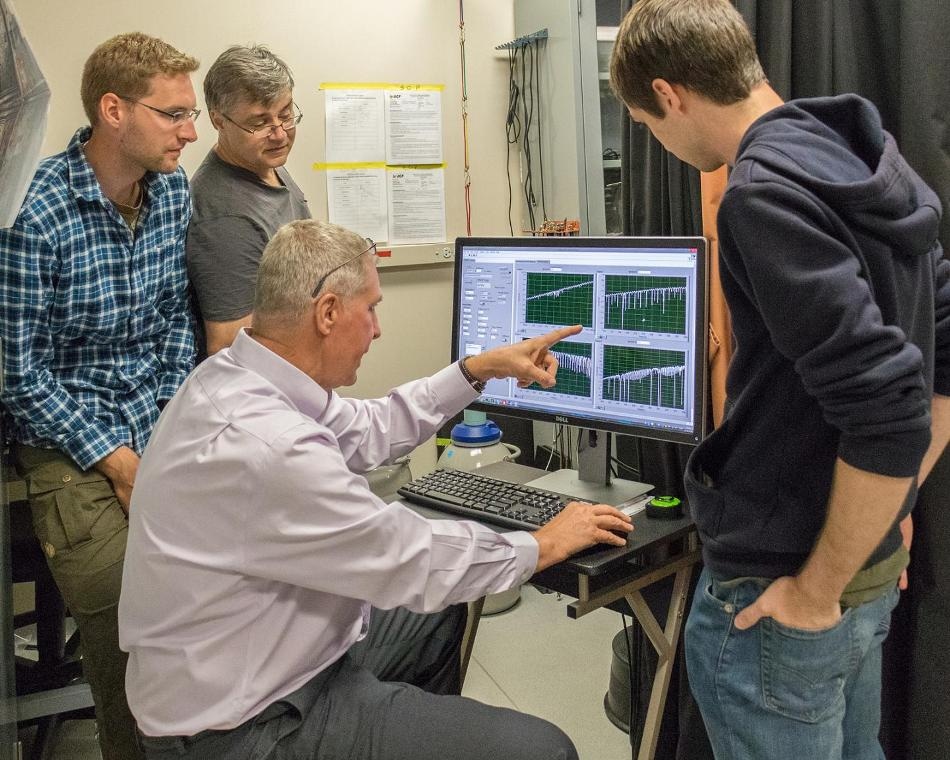Mar 29 2018
The Department of Homeland Security could reap the benefits of a dependable, real-time instrument with the ability to screen the atmosphere for toxic agents to alert people to a chemical or biological attack. Konstantin Vodopyanov, an optics and photonics Professor at UCF, has been working to develop exactly such a technology to achieve that.
 UCF optics and photonics Professor Konstantin Vodopyanov works with his team to broaden the range of the laser frequencies that can get the job done. If costs can be reduced and the tech made mobile, the applications could be endless, he said. (Image credit: UCF: Karen Norum)
UCF optics and photonics Professor Konstantin Vodopyanov works with his team to broaden the range of the laser frequencies that can get the job done. If costs can be reduced and the tech made mobile, the applications could be endless, he said. (Image credit: UCF: Karen Norum)
He has discovered an innovative technique to employ infrared lasers to detect even negligible amounts of chemicals in the atmosphere. Every chemical contains individual molecules vibrating at their own unique frequency. Vodopyanov has unearthed a process to use lasers to identify these vibrations.
The process is so sensitive and precise that the presence of any chemical molecule even at concentrations as negligible as one part per billion can be determined. Therefore, even if the toxic chemicals are hidden, his method could be applied to detect them.
The results of his research have been reported online in the Nature Photonics journal on March 26, 2018.
“We still have much work ahead,” he stated. “We are now working on broadening the range of the laser frequencies that can get the job done. If costs can be reduced and the tech made mobile, the applications could be endless.”
In the medical field, a similar principle is used to detect biomarkers for various health conditions, such as cancer, by collecting breath samples.
According to Vodopyanov, the rules of physics make this possible.
“The frequencies of molecules are very distinct, but they are invariant—here, on a different continent, on a different planet, anywhere,” stated Vodopyanov. “It is universal. Think of it as a molecular fingerprint. So when we use the laser we can detect these fingerprints with great precision.”
The innovative process could lead to the development of non-invasive technology, such as sensors, that can be employed to detect:
- Traces of life by space explorers on missions to asteroids or other planets
- Airborne agents that could be experienced during a chemical or biological attack on the battlefield or at home
Technology To Detect Dangerous Chemicals
Andrey Muraviev from the UCF’s College of Optics & Photonics; Viktor Smolski of IPG Photonics Mid-Infrared Lasers in Birmingham, AL; and Zachary Loparo from UCF’s Department of Mechanical and Aerospace Engineering are the other collaborators on the Nature Photonics paper.
Vodopyanov received his doctorate from the Lebedev Physical Institute in Moscow. He has dedicated many years toward teaching and performing research in Russia, Germany, the United Kingdom, and Stanford University in California before joining UCF in 2013. He has also worked in the industry, including the Silicon Valley start-up Picarro, which was creating a laser-based breath analyzer for early detection of ulcers. He has authored over 300 papers and is sponsored by many different organizations, such as NASA, Air Force, Office of Naval Research, and the Defense Advanced Research Projects Agency